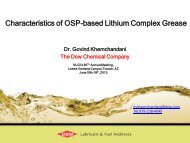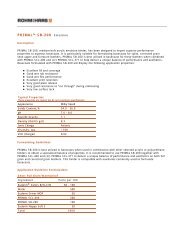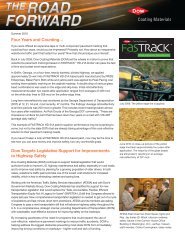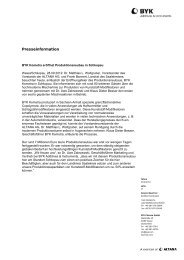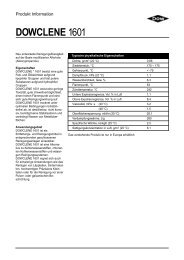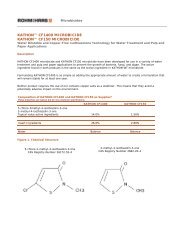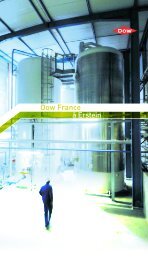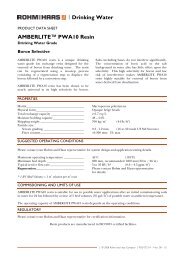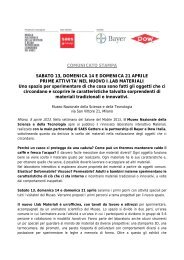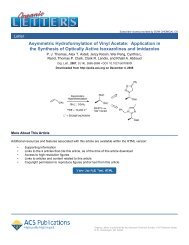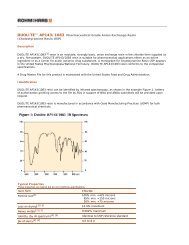The Future of Fuels and Alternative Feedstocks - The Dow Chemical ...
The Future of Fuels and Alternative Feedstocks - The Dow Chemical ...
The Future of Fuels and Alternative Feedstocks - The Dow Chemical ...
You also want an ePaper? Increase the reach of your titles
YUMPU automatically turns print PDFs into web optimized ePapers that Google loves.
Dr. William F. Banholzer<br />
Executive VP <strong>and</strong> CTO<br />
<strong>The</strong> <strong>Dow</strong> <strong>Chemical</strong> Company<br />
<strong>The</strong> <strong>Future</strong> <strong>of</strong> <strong>Fuels</strong> <strong>and</strong> <strong>Alternative</strong><br />
<strong>Feedstocks</strong> – Recognizing Hype vs.<br />
Practical Limitations
Engineering<br />
Too much hype for the<br />
possible <strong>and</strong> not enough focus<br />
on the practical<br />
<strong>Chemical</strong> Engineering is letting<br />
society down!
Business vs. Academic Success<br />
Impact<br />
to Society<br />
Business<br />
Success<br />
Challenges<br />
to Society<br />
What people want ≠ What<br />
they will pay for ≠ What<br />
they can afford<br />
What they will pay for<br />
impacts society<br />
Risk vs.<br />
Reward<br />
Invention<br />
Economic<br />
Viability<br />
Academic<br />
Success
Impact to Society = Business Success<br />
Business Success vs. SCIENCE<br />
Low High<br />
H 2 fuel cells<br />
SkyMine®<br />
Man Made Diamonds<br />
Transistors<br />
LEDs<br />
Ethylene Styrene<br />
Interpolymers<br />
Antibiotics<br />
Low Quality <strong>of</strong> Science High
Energy Sources Have Changed<br />
Fracion <strong>of</strong> Total Energy<br />
Consumed<br />
100%<br />
90%<br />
80%<br />
70%<br />
60%<br />
50%<br />
40%<br />
30%<br />
20%<br />
10%<br />
0%<br />
What’s Changed?<br />
• Oil Price Rise<br />
• CO2 awareness<br />
Source: IEA. EIA; US Primary Energy<br />
1850<br />
1860<br />
Biomass<br />
Migration to higher energy<br />
density, more available,<br />
lower cost sources<br />
1870<br />
1880<br />
1890<br />
1900<br />
1910<br />
1920<br />
Coal<br />
1930<br />
1940<br />
1950<br />
1960<br />
Natural Gas<br />
Petroleum<br />
1970<br />
1980<br />
Is that enough?<br />
1990<br />
2000<br />
2009<br />
all other<br />
Hydro<br />
Nuclear
Funding Follows the Hype<br />
Published Articles Reflect the Focus<br />
on “Bio” Related Research:<br />
Biodiesel + Cellulosic<br />
Ethanol + Bioengineering<br />
Reactor Design +<br />
Transp. Phenomena<br />
+ Fluid Dynamics<br />
Top Strategic Universities<br />
Percentage <strong>of</strong> Faculty with “Bio”<br />
Related Research Interests:<br />
Dynamic range <strong>of</strong> the discipline is threatened by decreasing support <strong>of</strong><br />
the traditional core research areas.
Energy Industry Dynamics<br />
As oil price rises, new capital will flow to EOR, Arctic, Oil s<strong>and</strong>s, GTL, CTL before bi<strong>of</strong>uels.<br />
Total Production cost (2008 $/bbl)<br />
180<br />
130<br />
110<br />
90<br />
70<br />
50<br />
30<br />
10<br />
Recent price <strong>of</strong> oil<br />
margin<br />
OPEC Middle East<br />
Other OPEC<br />
Other<br />
Conventional<br />
Oil<br />
Predicted<br />
dem<strong>and</strong> till 2015<br />
Venezuelan<br />
Heavy Oil<br />
Deep Water<br />
0 20 40 60<br />
80 100 120<br />
FSU<br />
Million Barrels <strong>of</strong> Oil Equivalent per Day<br />
Source: IEA, EIA, Booz Allen Hamilton, DOE Biomass Multiyear Program Plan April 2011, <strong>Dow</strong> Analysis<br />
EOR<br />
A<br />
R<br />
C<br />
T<br />
I<br />
C<br />
Cellulosic<br />
Ethanol*<br />
Bi<strong>of</strong>uels<br />
(Corn Based)<br />
CTL<br />
GTL<br />
Oil Shale<br />
Oil S<strong>and</strong>s (in situ)<br />
Oil S<strong>and</strong>s (Mining)<br />
Bi<strong>of</strong>uels (Sugar Cane Based)<br />
Conventional Oil Non Conventional liquid sources<br />
*Based on DOE volume projections for US in<br />
2022. DOE price target is ~$113/bbl
Recognizing Fads<br />
<strong>The</strong> art <strong>of</strong> being wise is the art <strong>of</strong> knowing what to overlook - William James<br />
Hydrogen Car Corn Ethanol Biodiesel<br />
Cellulosic Ethanol<br />
"We asked ourselves, 'Is<br />
it likely in the next 10 or<br />
15, 20 years that we will<br />
convert to a hydrogen<br />
car economy?' <strong>The</strong><br />
answer, we felt, was 'no,‘”<br />
Steve Chu, Energy<br />
Secretary, May 2009<br />
Bio Plastics<br />
<strong>Dow</strong> launched the JV with<br />
Cargill in 1997 to develop<br />
<strong>and</strong> market PLA from corn,<br />
exited the JV in 2004.<br />
“…Using<br />
l<strong>and</strong> to<br />
grow fuel<br />
leads to the<br />
destruction<br />
<strong>of</strong> forests,<br />
wetl<strong>and</strong>s <strong>and</strong> grassl<strong>and</strong>s<br />
that store enormous<br />
amounts <strong>of</strong> carbon.”<br />
Michael Grunwald, TIME<br />
April 2007<br />
“Bi<strong>of</strong>uels are<br />
contributing to higher<br />
prices <strong>and</strong> tighter<br />
markets.”<br />
Timothy Searchinger,<br />
Princeton University<br />
April 2011<br />
“Sun Chips Bag to Lose Its Crunch”<br />
Photo: Associated Press<br />
Bio based packaging launched<br />
in 2009 but discontinued by<br />
late 2010, due to performance<br />
perception issues<br />
“…the need for trucks,<br />
machinery <strong>and</strong> manpower<br />
would come during harvest,<br />
already the busiest time <strong>of</strong> the<br />
year on the farm. And that’s<br />
where a massive federal<br />
initiative into cellulosic<br />
ethanol may find its<br />
biggest bottleneck – on the<br />
farm.”<br />
Robert Rapier<br />
Glycerin to Epi<br />
<strong>Dow</strong> postponed in 2009<br />
due to uncertain supply +<br />
Natural oil Polyols<br />
<strong>Dow</strong> Launched in 2007,<br />
exited in 2010.
Bi<strong>of</strong>uels Key Issues<br />
• How much biomass is available?<br />
not enough to replace fossil fuels<br />
• How much will the biomass cost?<br />
it is not cheap!<br />
• How much will bi<strong>of</strong>uels cost? more than fossil<br />
• How much more are we willing to pay? no premium<br />
• How realistic is chemical production from biomass?<br />
we already do, but chemical use doesn’t address the<br />
big issues<br />
NRC, "Renewable Fuel St<strong>and</strong>ard: Potential Economic <strong>and</strong> Environmental Effects <strong>of</strong> U.S. Bi<strong>of</strong>uel Policy", 4 October 2011.
Migration to Higher Energy Density Sources<br />
Btu/lb<br />
20000<br />
15000<br />
10000<br />
5000<br />
0<br />
Crude Oil<br />
Coking coal<br />
Crude oil is three times as<br />
energy dense as biomass<br />
Biomass<br />
0 1 2 3 4<br />
Energy<br />
Equivalency<br />
1 Oil<br />
Refinery<br />
27 Power<br />
Plants<br />
60 Ethanol<br />
Refineries<br />
$ Capital /<br />
Usable MM Btu<br />
$164<br />
$167<br />
$321*<br />
*l<strong>and</strong> & water penalty not included<br />
Energy from fossil infrastructure built over 80-100 years defines our current st<strong>and</strong>ard <strong>of</strong> living<br />
Sources: Heating values from GREET, Argonne National Lab, May 2008; Refinery size <strong>and</strong> economics by Oil & Gas Journal construction update, Dec 2010; Coal fired<br />
plant economics <strong>and</strong> size from Congressional Research Service report 2008; Ethanol plant <strong>of</strong> 100 MM gal/yr from DOE targets <strong>and</strong> economics estimated internally
<strong>The</strong> Cellulosic Fad<br />
High cash <strong>and</strong> capital costs<br />
improved<br />
performance due<br />
mainly to higher yield<br />
(gal/bdt)<br />
E<br />
TC + waste<br />
Sources:<br />
Crude Oil price, CMAI, Spot Average FOB price; monthly average prices from Jan 2005 to Jan 2011<br />
Targets from DOE for Biochemical <strong>and</strong> <strong>The</strong>rmochemical routes; Capital from Biomass Multi Year Program 201 report from DOE (revisited by DOE on Nov 2010)<br />
Corn Ethanol from the Center <strong>of</strong> Agricultural <strong>and</strong> Rural Development from Jan 2005 to Jan 2011<br />
D<br />
BC + ag residue
Scale <strong>of</strong> <strong>Fuels</strong> Makes it Harder<br />
Original Inv.<br />
Capital for Single Plant<br />
Largest Social<br />
Community on<br />
Internet<br />
0.05% <strong>of</strong> Global<br />
Electricity Generation<br />
Revenue $1051MM/y<br />
0.02% <strong>of</strong> Global<br />
Electricity Generation<br />
Revenue $441MM/y<br />
2% <strong>of</strong> Global MEG<br />
Consumption<br />
0.3% <strong>of</strong> Global<br />
Ethylene consumption<br />
Dt<br />
~10s y<br />
Sources: facebook original investment showing combined amounts from Peter Thiel (PayPal c<strong>of</strong>ounder), Accel Partners <strong>and</strong> Greylock Partners as described in the History<br />
<strong>of</strong> facebook on wikipedia; Power Plants: RL34746 report - Stan Kaplan - Congressional Research Service; MTO: PEP Report 261 – SRI <strong>and</strong> EG: PEP Repor 2I – SRI; Revenues<br />
for Power Plants calculated using 2010 electricity average retail prices (all sectors) 9.88 cents/kWh (data from DOE)<br />
~$B<br />
Activation Capital<br />
t
Timeline for Impact<br />
Single Site<br />
Catalysis<br />
Super Critical<br />
Coal Power<br />
Impact / Market Penetration<br />
$<br />
t<br />
$<br />
t<br />
Invention Development<br />
~$10s MM<br />
Sources: SRI PEP LLDPE 36E 2008, SRI PEP 153B 2001 Single site catalysts for PE<br />
Production, AEP Power Co, World Bank, EIA 2011 Energy Outlook, Electricity Market Module<br />
Demonstration<br />
Deployment<br />
~$50 MM ~$150 MM*<br />
1957, 80 1980-90 1989 1991 S ~12 yrs<br />
~$100s MM<br />
~$500+ MM<br />
~$2 B**<br />
1920 1930 -50s 1957 1970s S ~50 yrs<br />
*400 mT LLDPE plant, 2008$<br />
**600 MW plant, 2009$
<strong>Alternative</strong> Feedstock - Cane to LLDPE<br />
Ethanol<br />
Ethylene<br />
Fully-integrated facility in Brazil<br />
Utilizes state-<strong>of</strong>-the-art <strong>Dow</strong><br />
polymerization catalysis
Ethanol to PE – A Niche Opportunity<br />
Market prices <strong>and</strong> selected costs on energy equivalent basis<br />
• Existing logistics for<br />
ethanol in Brazil<br />
• High polyethylene price in<br />
Brazil<br />
• Ethanol price fluctuation<br />
requires integration<br />
Area required for produce<br />
ethanol to meet global PE<br />
production ~ 1x <strong>of</strong><br />
Minnesota at Brazil cane<br />
productivity<br />
Costs*<br />
USA Brazil<br />
Market Prices<br />
USA Brazil<br />
$/MMBTU<br />
cents/gal<br />
UNITED STATES BRAZIL<br />
Ethane<br />
cents/lb<br />
Ethylene<br />
$/gal cents/lb<br />
Ethanol<br />
Polyethylene<br />
Ethanol<br />
cents/lb<br />
Polyethylene<br />
Sources: Ethane, ethylene, polyethylene (US): CMAI; Ethanol US: ICIS, Ethanol Br: ESALQ; PE Brazil calculated based on market price differential Br to US. Price Densities shown for June 2009 to June 2011;<br />
Prices shown from June 2011. *Costs: 2009 US cash cost Ethylene CMAI, US EtOH cost to blender: SRI 2011; Br EtOH: Data Agro 2009 <strong>and</strong> Estado de S. Paulo 2007 adjusted to 2011 exchange rate<br />
$/gal
Bio Commodities Too Expensive<br />
Cash cost indifference analysis for ethylene from crude oil <strong>and</strong> bio feedstocks<br />
*Excludes Capital
What are we doing?<br />
R&D goal is to extract more earnings per dollar <strong>of</strong> investment<br />
Energy<br />
Storage<br />
Superior Materials:<br />
Cathode<br />
Anode<br />
Electrolytes<br />
Separator<br />
<strong>Dow</strong> chooses to operate where<br />
materials science expertise drives success<br />
Energy<br />
Efficiency<br />
Superior Materials:<br />
Energy efficiency<br />
improvements for<br />
commercial <strong>and</strong><br />
industrial products<br />
Energy<br />
Generation<br />
Superior Materials:<br />
Efficiency<br />
Yield<br />
Performance<br />
Durability
Final Thoughts<br />
• Too much hype for the possible <strong>and</strong> not enough focus on the<br />
practical<br />
• Incumbent fossil sources set the st<strong>and</strong>ard for competition<br />
• It takes decades to deploy a new technology<br />
• Scale wins <strong>and</strong> biomass availability limits bi<strong>of</strong>uels scale<br />
• Small companies access to capital makes success challenging<br />
• Fundamental engineering judgment is crucial to long term<br />
innovation<br />
• Can society afford to pay for a different solution?<br />
Facts are the air <strong>of</strong> scientists. Without them you can never fly.<br />
- Linus Pauling
<strong>Dow</strong> Supports <strong>Chemical</strong> Engineering<br />
• $250 million total program<br />
• foster better balance<br />
• 10 year program<br />
• 11 major universities<br />
• areas<br />
– catalysis<br />
– process development<br />
– new materials<br />
• electronics<br />
• energy<br />
• transportation<br />
• consumer applications
Thank You



